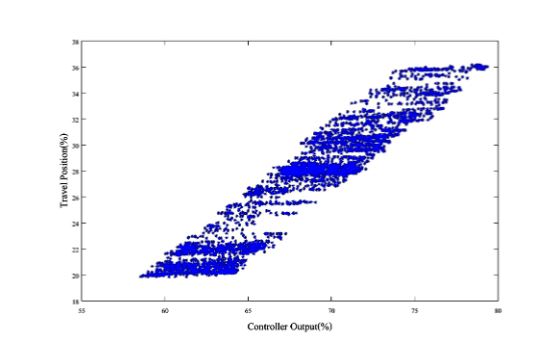Quantification of Valve Stiction using Particle Swarm Optimisation with Linear Decrease Inertia Weight
Main Article Content
Abstract
Valve stiction is one of the most common problems on industrial process control loops. The detection and quantification of valve stiction in control loops is therefore important to ensure the high quality of the products and maintain the reliable performance of control loops. This paper presents an algorithm for quantifying valve stiction in control loop based on linear decrease inertia weight particle swarm optimization to obtain more accurate estimates of stiction parameters. The amount of stiction present in the valve is estimated by identifying parameters of Kano model which is a two-parameter data-driven stiction modelling based on the parallelogram of MVPV phase plot. Simulation results have demonstrated the efficacy of this algorithm in valve stiction quantification and also its robustness to oscillations due to inappropriate controller tuning and external disturbances. Results are confirmed by application to real process industrial data.
Article Details
References
M.A.A. S. Choudhury, M. Jain and S. L. Shah, “Stiction - Definition, Modelling, Detection and Quantification,” Journal of Process Control, Vol. 18, No. 3-4, pp. 232-243, March 2008.
M. Jelali, Control Performance Management in Industrial Automation, 1st ed., UK: Springer- Verlag London, 2013, pp. 266.
M. Jelali and B. Huang, Detection and Diagnosis of Stiction in Control Loops: State of the Art and Advanced Methods, 1st ed., UK:Spinger-Verlag London, 2010.
A. Stenman, F. Gustafsson, and K. Forsman, “A Segmentation-based Method for Detection of Stiction in Control Valves,” International Journal of Adaptive Control and Signal Processing, Vol. 17, No. 7-9, pp. 625-634, September - November 2003.
M. Kano, H. Maruta, H. Kugemoto, and K. Shimizu, “Practical Model and Detection Algorithm for Valve Stiction,” Proceedings of 7th IFAC DYCOPS, Cambridge, USA, 2004.
Q. P. He, J. Wang, M. Pottmann, and S. J. Qin, “A Curve Fitting Method for Detecting Valve Stiction in Oscillating Control Loop,” Industrial & Engineering Chemistry Research, Vol. 46, No. 13, pp. 4549-4560, 2007.
M.A.A.S. Choudhury, S.L. Shah, N.F. Thornhill, “Diagnosis of Poor Control Loop Performance using Higher Order Statistics,” Automatica, Vol. 40, No. 10, pp.1719-1728, 2004.
D. Karnopp, “Computer Simulation of Stick- Slip Friction in Mechanical Dynamic Systems,” Journal of Dynamic Systems, Measurement, and Control, Vol. 107, No. 1, pp. 100-103, 1985.
C. C. de Wit, H. Olsson, K. J. ˚Astr¨om, and P. Lischinsky, “A New Model for Control of Systems with Friction,” IEEE Transactions of Automatic Control, Vol. 40, No 3, pp. 419-425, 1995.
M. A. A. S. Choudhury, N. F. Thornhill, and S. L. Shah, “A Data- Driven Model for Valve Stiction,” Proceedings of 5th ADCHEM, Hong Kong, China, 2004, pp. 261-266.
C. Garcia, “Comparison of Friction Models Applied to a Control Valve,” Control Engineering Practice, Vol. 16, No. 10, pp. 1231-1243, October 2008.
S. Sivagamasundari and D. Sivakumar, “Estimation of Valve Stiction Using Particle Swarm
Optimization,” Sensors & Transducers Journal, Vol. 129, pp. 149-162, 2011.
A. Nikabadi and M. Ebadzadeh , “Particle Swarm Optimization Algorithms with Adaptive Inertia Weight : A Survey of the State of the Art and a Novel Method,” IEEE Journal of Evolutionalry Computation, 2008.
Y. Feng, G. F. Teng, A. X. Wang, and Y. M. Yao, “Chaotic Inertia Weight in Particle Swarm Optimization,” Proceedings of 2nd International Conference of Innovative Computing, Information and Control, Kumamoto, 2007, p. 475.
J. Xin, G. Chen, and Y. Hai., “A Particle Swarm Optimizer with Multistage Linearly-Decreasing
Inertia Weight,” Proceedings of International Joint Conference on Computational Sciences and Optimization, Sanya, Hainan, 2009, pp. 505- 508.
Y. Shi and R. C. Eberhart, “Empirical Study of Particle Swarm Optimization,” Proceeding of the 1999 Congress on Evolutionalry Computation, Washington, DC, 2002, pp. 1945-1950.
J. C. Bansal, P. K. Singh, M. Saraswat, A. Verma, S. S. Jadon, and A. Abraham, “Inertia Weight Strategies in Particle Swarm Optimization,” Proceedings of 3rd World Congress on Nature and Biologically Inspired Computing, Salamanca, 2011, pp.640-647.


